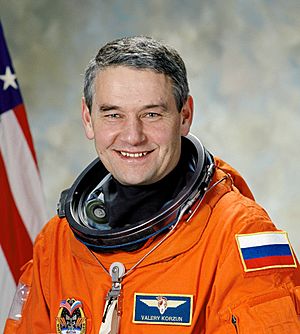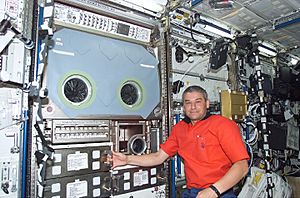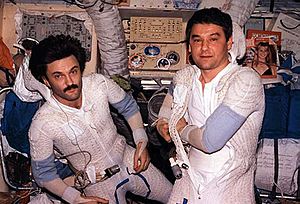Valery Korzun facts for kids
Quick facts for kids
Valery Grigoryevich Korzun
Валерий Григорьевич Корзун |
|
|---|---|
 |
|
| Born | 5 March 1953 Krasny Sulin, Rostov Oblast, Russian SFSR, Soviet Union
|
| Status | Retired |
| Nationality | Russian |
| Occupation | Pilot |
| Awards | |
| Space career | |
| Roscosmos cosmonaut | |
| Rank | Colonel |
|
Time in space
|
381d 15h 41min |
| Selection | 1987 TsPK Cosmonaut Group |
|
Total EVAs
|
4 |
|
Total EVA time
|
22 hours 19 minutes |
| Missions | Soyuz TM-24, STS-111, Expedition 5, STS-113 |
|
Mission insignia
|
|
Valery Grigoryevich Korzun is a retired Russian cosmonaut. He was born on March 5, 1953. He has traveled to space two times. In total, he spent 381 days living and working in space. He also performed four spacewalks during his career.
Contents
About Valery Korzun
Valery Korzun was born on March 5, 1953, in Krasny Sulin, Russia. He is a retired Colonel from the Russian Air Force. He also worked as a cosmonaut at the Yuri Gagarin Cosmonaut Training Center. Valery and his wife, Elana, have one son named Nikita. His hobbies include playing tennis and badminton. He also enjoys going to the theater.
Education and Training
Valery Korzun finished the Kachinsk higher military aviation pilot school in 1974. This is where he learned to fly military planes. Later, in 1987, he graduated from the Gagarin Military Aviation Academy.
Awards and Honors
Valery Korzun has received several important awards for his work.
- He was given the title of Hero of Russian Federation. This is a very high honor in Russia.
- He also earned the title of Pilot-Cosmonaut of the Russian Federation.
- France awarded him the Cavalier of Legion of Honour.
He has also received many medals from Russia and NASA.
Military Experience
After finishing military college in 1974, Korzun became a pilot. He moved up in rank to become a senior pilot. Then he led a flight section. Eventually, he became the commander of a Soviet Air Force squadron. He is a top-level military pilot. He has flown for 1473 hours, mostly in four different types of aircraft. He is also an expert in parachute training. He has completed 377 parachute jumps.
Cosmonaut Career
In 1987, Valery Korzun was chosen to train as a cosmonaut. This happened after he successfully commanded the Gagarin Military Air-Force Academy. He started his cosmonaut training in December 1987. By June 1989, he was certified as a Test-Cosmonaut.
From 1989 to 1992, he trained for space flights. He also trained to be the commander of the Soyuz-TM rescue spacecraft. From 1994 to 1995, he trained to fly on the Mir orbital complex. He also helped supervise crew communication for flight training.
In August 1996, Korzun finished training to command the Mir-22/NASA-3 mission. He also trained for the "Cassiopia" program.
First Space Mission: Mir EO-22
Valery Korzun's first trip to space began on August 17, 1996. He launched aboard the Soyuz TM-24 spacecraft. His crewmates were cosmonaut Alexander Kaleri and French astronaut Claudie Haigneré. The Soyuz spacecraft took off from the Baikonur Cosmodrome.
Two days later, on August 19, the Soyuz docked with the Mir space station. Korzun and Kaleri became the 22nd crew to live on Mir. They worked with NASA astronauts Shannon Lucid, John Blaha, and Jerry Linenger. On March 2, 1997, Korzun, Kaleri, and ESA astronaut Reinhold Ewald returned to Earth. The Soyuz capsule landed in Kazakhstan. Korzun spent 196 days, 17 hours, and 26 minutes in space on this mission.
Second Space Mission: Expedition 5
The Expedition 5 crew launched on June 5, 2002. They flew aboard the Space Shuttle STS-111. The shuttle lifted off from the Kennedy Space Center. After two days, the Endeavour shuttle docked with the International Space Station (ISS). Valery Korzun was the commander of the Expedition 5 crew.
The Expedition 5 crew performed about 25 new science experiments on the ISS. They also continued other experiments that had already started. These studies looked at things like cold plasma, how crystals grow, and how space radiation affects the human body. Some medical experiments focused on blood, muscles, and bones. The crew also did experiments about psychology. Korzun also took part in environmental experiments. He watched Earth's surface from space. Observing Earth from space helps people on the ground. For example, it can quickly tell them about disasters like fires and floods.
The Expedition 5 crew returned to Earth on December 7, 2002. They came back on Space Shuttle Endeavour's STS-113 mission. The shuttle landed at Kennedy Space Center. After this second long spaceflight, Korzun had spent 184 days and 22 hours in space.
Spacewalks
Valery Korzun has completed four spacewalks in his career. During his Mir EO-22 mission, he did two spacewalks. These spacewalks lasted a total of 12 hours and 33 minutes. During ISS Expedition 5, he did two more spacewalks. These lasted 9 hours and 46 minutes.
On December 2, 1996, Korzun did his first spacewalk with cosmonaut Aleksandr Kaleri. Their main goal was to connect a new solar array. This would give the Mir station more electrical power. The spacewalk lasted 5 hours and 57 minutes. They installed cables for the solar array.
Korzun performed his second spacewalk on December 9, 1996. The goal was to finish connecting the new solar array. He and Kaleri completed the cable installation. They also attached a Kurs docking antenna. This spacewalk lasted 6 hours and 38 minutes.
Korzun did two spacewalks during his six months on the ISS. On August 16, 2002, he performed his third spacewalk with NASA astronaut Peggy Whitson. They had a late start because they forgot to open an oxygen valve in their Russian Orlan spacesuits. The airlock had to be refilled with air. This delay cut their spacewalk short to 4 hours and 25 minutes. The goal was to protect the ISS from space debris. Korzun and Whitson installed six debris panels onto the Zvezda Service Module. These panels help shield Zvezda from possible impacts by space debris.
Korzun performed his fourth spacewalk on August 26, 2002. The start was delayed due to an air leak between the airlock and the Zvezda module. This problem was fixed quickly. Despite the delay, Korzun and Sergei Treshchov finished all their tasks. Wearing Russian Orlan spacesuits, they installed a frame on the outside of the Zarya module. This frame will hold parts for future spacewalks. They also put new material samples on Japanese experiments outside Zvezda. They installed devices on Zvezda to make future spacewalks easier. The two spacewalkers also added two ham radio antennas on Zvezda. This will improve amateur radio operations from the station. This spacewalk lasted 5 hours and 21 minutes.
See also
 In Spanish: Valery Korzun para niños
In Spanish: Valery Korzun para niños




